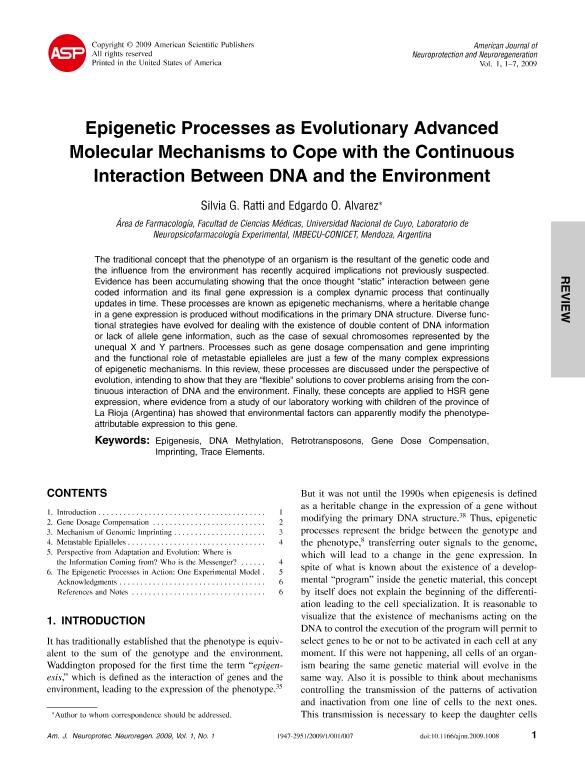Mostrar el registro sencillo del ítem
dc.contributor.author
Ratti, Silvia Gabriela

dc.contributor.author
Alvarez Toro, Edgardo Orozimbo

dc.date.available
2019-07-26T14:40:36Z
dc.date.issued
2009-06
dc.identifier.citation
Ratti, Silvia Gabriela; Alvarez Toro, Edgardo Orozimbo; Epigenetic Processes as Evolutionary Advanced Molecular Mechanisms to Cope with the Continuous Interaction Between DNA and the Environment; American Scientific Publishers; American Journal of Neuroprotection and Neuroregeneration; 1; 1; 6-2009; 40-46
dc.identifier.issn
1947-2951
dc.identifier.uri
http://hdl.handle.net/11336/80369
dc.description.abstract
The traditional concept that the phenotype of an organism is the resultant of the genetic code and the influence from the environment has recently acquired implications not previously suspected. Evidence has been accumulating showing that the once thought “static” interaction between gene coded information and its final gene expression has revealed as a complex dynamic process that continually updates in time. These processes are known as epigenetic mechanisms, where a heritable change in a gene expression is produced without modifications in the primary DNA structure. Diverse functional strategies have been evolved in evolution dealing the existence of double content of DNA information or lack of allele gene information, such as the case of sexual chromosomes represented by the unequal X and Y partners. Processes such as the gene dosage compensation, gene imprinting and the functional role of metastable epialleles, are just a few of the many complex expressions of epigenetic mechanisms. In this review these processes are discussed under the perspective of evolution, intending to show that they are “flexible” solutions to cover problems arising from the continuous interaction of DNA and the environment. Finally, these concepts are applied to the HSR gene expression where evidence from a study of our laboratory working in children of the province of La Rioja (Argentina) has showed that environmental factors can apparently modify the phenotypic attributable expression to this gene.
dc.format
application/pdf
dc.language.iso
eng
dc.publisher
American Scientific Publishers

dc.rights
info:eu-repo/semantics/openAccess
dc.rights.uri
https://creativecommons.org/licenses/by-nc-sa/2.5/ar/
dc.subject
Epigenesis
dc.subject
Dna Methylation
dc.subject.classification
Neurociencias

dc.subject.classification
Medicina Básica

dc.subject.classification
CIENCIAS MÉDICAS Y DE LA SALUD

dc.title
Epigenetic Processes as Evolutionary Advanced Molecular Mechanisms to Cope with the Continuous Interaction Between DNA and the Environment
dc.type
info:eu-repo/semantics/article
dc.type
info:ar-repo/semantics/artículo
dc.type
info:eu-repo/semantics/publishedVersion
dc.date.updated
2019-06-10T21:23:52Z
dc.identifier.eissn
1947-296X
dc.journal.volume
1
dc.journal.number
1
dc.journal.pagination
40-46
dc.journal.pais
Estados Unidos

dc.description.fil
Fil: Ratti, Silvia Gabriela. Universidad Nacional de Cuyo. Facultad de Ciencias Médicas; Argentina
dc.description.fil
Fil: Alvarez Toro, Edgardo Orozimbo. Consejo Nacional de Investigaciones Científicas y Técnicas. Centro Científico Tecnológico Conicet - Mendoza. Instituto de Medicina y Biología Experimental de Cuyo; Argentina
dc.journal.title
American Journal of Neuroprotection and Neuroregeneration
dc.relation.alternativeid
info:eu-repo/semantics/altIdentifier/doi/http://dx.doi.org/10.1166/ajnn.2009.1008
dc.relation.alternativeid
info:eu-repo/semantics/altIdentifier/url/https://www.ingentaconnect.com/content/asp/ajnn/2009/00000001/00000001/art00005%3bjsessionid=4t4cepor583eo.x-ic-live-02
Archivos asociados
